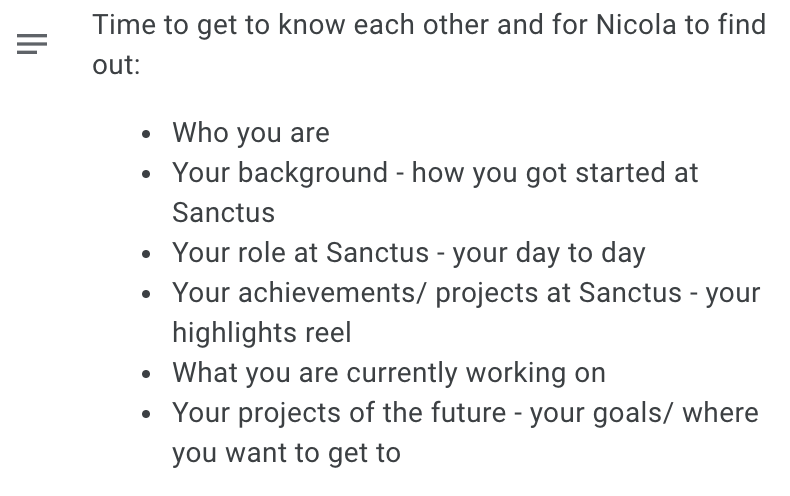Virtually onboarding a new employee
If you’re a business that’s still hiring right now and having to onboard your new joiner entirely over a laptop…we feel you.
It’s not easy and it’s not ideal.
While it can seem like a real challenge – in reality, not that much has actually changed. You can still conduct onboarding presentations, catchups, team meets and team lunches over video calls.
The part that has become harder is the loss of the physical connection and interaction, and for managers to get a real sense of how someone is settling in.
We’ve been impacted by this ourselves when onboarding a new joiner (Nicola), so below have listed a few tips for how to keep the process smooth and easy for everyone involved; the new joiner, the team and the manager.
We’ve also asked Nicola for some insight about what her first few weeks has been like 🙂
The actual onboarding process
This one seems obvious, but still worth mentioning.
We kept the actual onboarding process – presentations, training etc, the same, but simply conducted over a laptop instead. We’ve shared the same documents, and used screen share to walk through all the training systems.
On top of this, we also invited Nicola to a load of calls and meetings amongst other parts of the business to help her get a feel for what happens elsewhere; a feeling that might be missed by not being in the office around others.
We’ve also included her on plenty of external calls too so she can get a feel for our tone and style when externally facing.
Water-cooler chat
A big thing that goes missing is that 10-minute chat with some of the team in the kitchen or at the lunch table.
It can mean the majority of the chat is only about work, and it makes it harder for a new joiner to settle into the culture.
We’ve kept that up where possible in a few ways:
- Morning phone calls – just hearing the voice of each other rather than over Slack or email
- Making sure Nicola was invited to all the right Slack channels, including the random or non-work related ones we have where the poor banter takes place
- We still host socials with things like quiz nights and end-of-week celebrations
- We’ve made some of these socials silly and light-hearted, mostly through the use of dodgy fancy dress costumes. This can also help a new joiner feel at ease and much more part of a team
- We have a daily virtual tea break at 11-am for whoever is available to jump on and have a natter
I don’t think any of these things are particularly groundbreaking and I’ve seen most companies doing most, if not all of these, but it’s a useful list if you don’t know where to start 🙂
Meeting the team
We ran 30-min 1:1 “speed dates” between Nicola and the rest of the team so that she could meet all of them, find out about their roles and how she’d likely be working with them.
We booked all of them into the calendar with these questions in the invite:

If you’re a larger business I know it’s not sustainable to book in hundreds of meetings, but at least doing it with everyone your new joiner(s) will be working with is useful.
Real, meaningful check-ins
It’s likely that you’ll be catching up with new starters several times over the first few weeks and months.
“How are you finding settling in?” and “how’s the work going?” will be common questions.
But it’s important to not forget their emotional wellbeing too.
Joining any new job is a scary, daunting task. Throw a complete remote onboarding and global pandemic into the mix, and it’s fair to say that any employee, new or otherwise, will have their ups and their downs.
Take time in your check-ins and 1:1s to ask how people are really doing. This can apply to any employee – however long they’ve been at the company. But it’s especially important for a new starter who may not yet feel comfortable enough to be honest about where they’re at.
We run optional reflection spaces every couple of weeks where the company comes together to share how they’re really feeling. Some bring anger, sadness or grief, some bring excitement, happiness or boredom.
Nothing’s off the table in those spaces and it gives the team a chance to get things off their chest and to connect in a real, meaningful way.
Be flexible with your working schedule
Again, it goes without saying that things are bloody weird right now. It can be an overwhelming, scary time for anyone – particularly your first few weeks in a new job.
Be flexible with the schedule that you’ve set a new starter. Full days or full weeks might be a little too much at the start.
Or they might wake up one Thursday morning and not be in the best headspace. Forcing them to log on will only do themselves, you and the business more harm than good.
Allow people to take time off, or blocks of time off within days, if they need it.
Again, I’d recommend allowing this for anyone within the business.
Getting new starters involved
This won’t be for every new joiner as they’ll take different times to settle in, but in her second week Nicola ran a virtual lunch-and-learn for us.
This felt like a big step forward for her and gave her the chance to establish and introduce herself properly to the team.
Again, this is a big thing for anyone and some wouldn’t be comfortable with this, but think about other ways you can bring new joiners into the mix.
Perhaps it’s asking for their opinion in team meetings or on a specific piece of work, or maybe asking them to help organise a virtual social.
Anything you can do to get people involved in the more day-to-day side of the business will help them feel a bigger part of the company.
Managing a new joiner
It can be a particular challenge for managers right now who can’t physically see or interact with a new employee to see how they’re getting on.
It’s important to have regular check-ins booked in, at least for the first couple of months. Having these each week will help to build some normality into a new joiner’s calendar.
And a lot can happen in a week, both personally and professionally, so you don’t want to leave too much time in between.
In between these, popping them a message each day in the morning to say hello and to check-in is a nice way to keep up the interaction when you aren’t checking in, and also gives any new starter an opportunity to be honest with how they’re feeling that day.
We have separate “pulse” meetings at the start of each week where we reflect on the work of the previous week and look at what’s upcoming this week.
We’ve also had a couple of “co-working” spaces where a few of us jump on the camera to work together. We crack on as normal but it’s nice having a few people “there” with us and to have some light chat.
Essentially, we’ve been giving Nicola lots of spaces and opportunities to check-in, ask questions, and to share how she’s been feeling and coping.
Starting any new role brings plenty of change and uncertainty with it, and this is harder when physical contact and connection are removed. So whatever your onboarding process looks like, make plenty of time and spaces for your new joiners in both their role, and also for them as humans 🙂
Enter stage left – Nicola!
Here’s Nicola talking about how she’s found her first few weeks after having been virtually onboarded.
“Remote working and virtual onboarding is not the way I planned to start my new job. Bar interviews I haven’t really met any of the team, and I haven’t worked in the office. My main worry when I first started was that I wouldn’t connect with the job or my team, and that this would have a lasting impact on my relationship with Sanctus and my role. Now I’m 5 weeks in I’m pretty certain that isn’t the case. But it’s still weird.
It’s weird trying to put across your personality on Zoom calls and Slack messages. It’s weird not knowing everyone’s little quirks and habits and not partaking in standard office chit-chat. It’s weird missing hanging out with my team even though I’ve not met them yet.
Everyone at Sanctus has been amazing, though. All my onboarding and training happened the same way it would if I was in the office, and the support I have been given hasn’t faltered. If anything, I’ve probably had more support and been more on people’s mind because of my weird start!
I have weekly check-ins with my Line Manager, daily and weekly check-ins with my direct team, and wider team catch-ups both work and non-work related throughout the week. I’ve been given the freedom to check out and go for a walk if I need it, or to be able to finish early or work later depending on what I need.
I’ve had ups and downs like everyone else in this period, but overall I really feel like I’m part of the team and I think that will only be cemented once we all catch-up in person for the first time – I can’t wait!”

